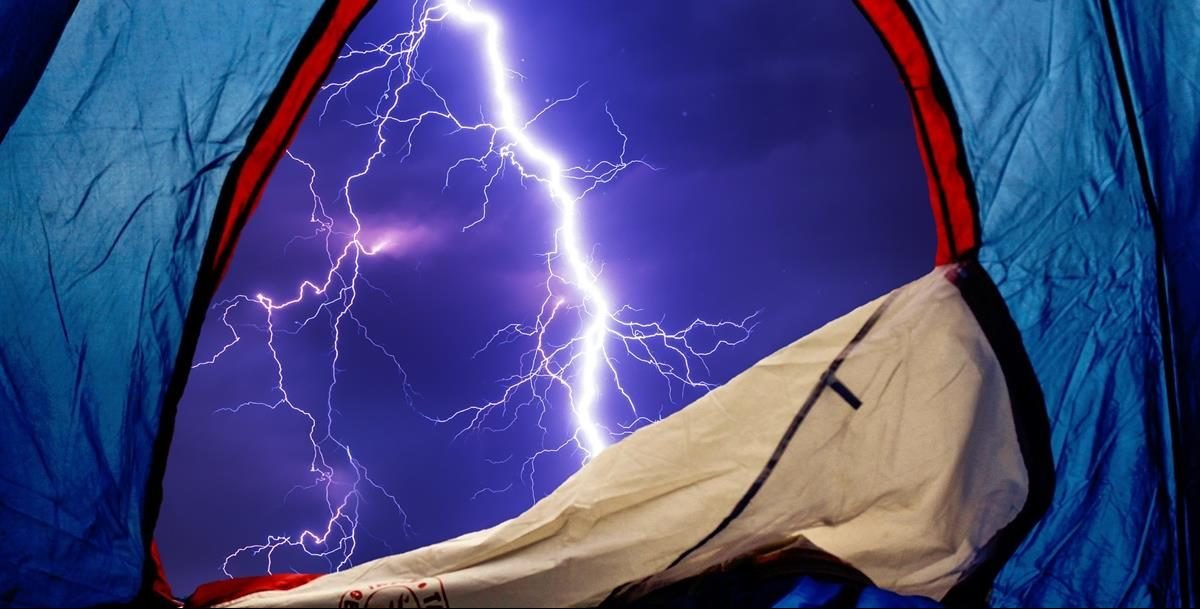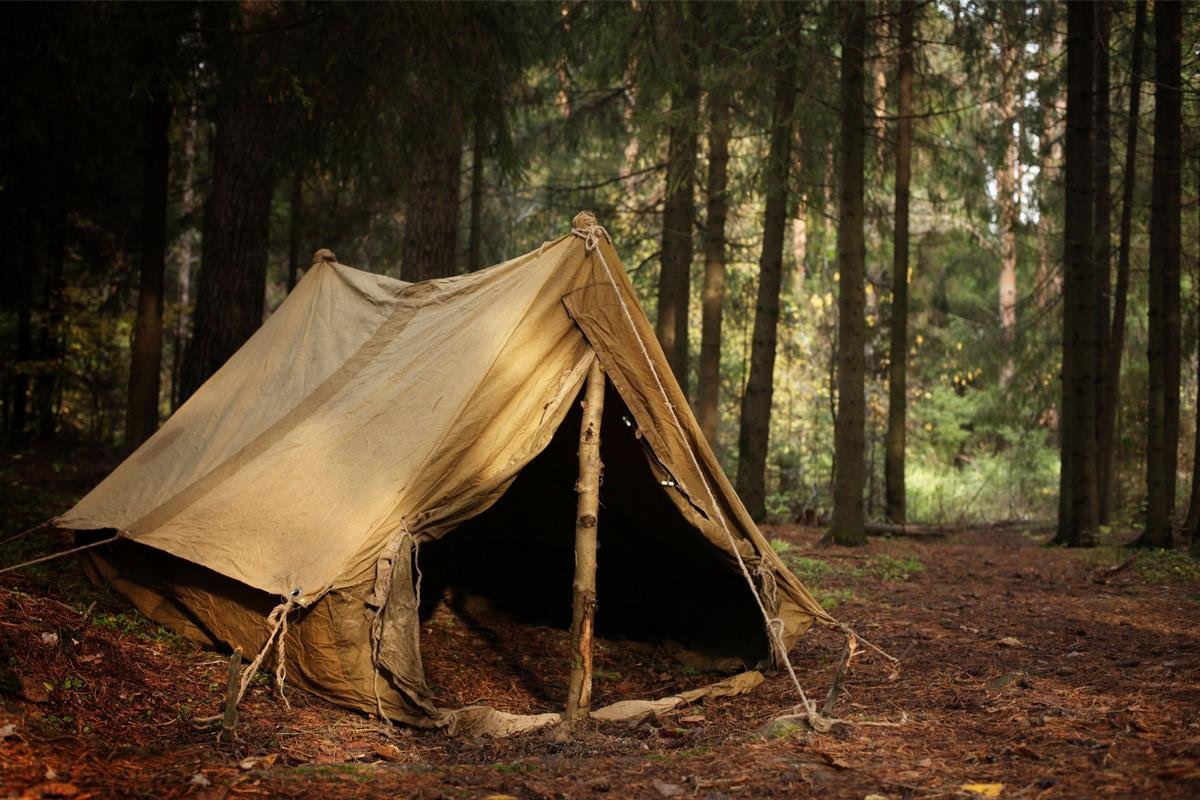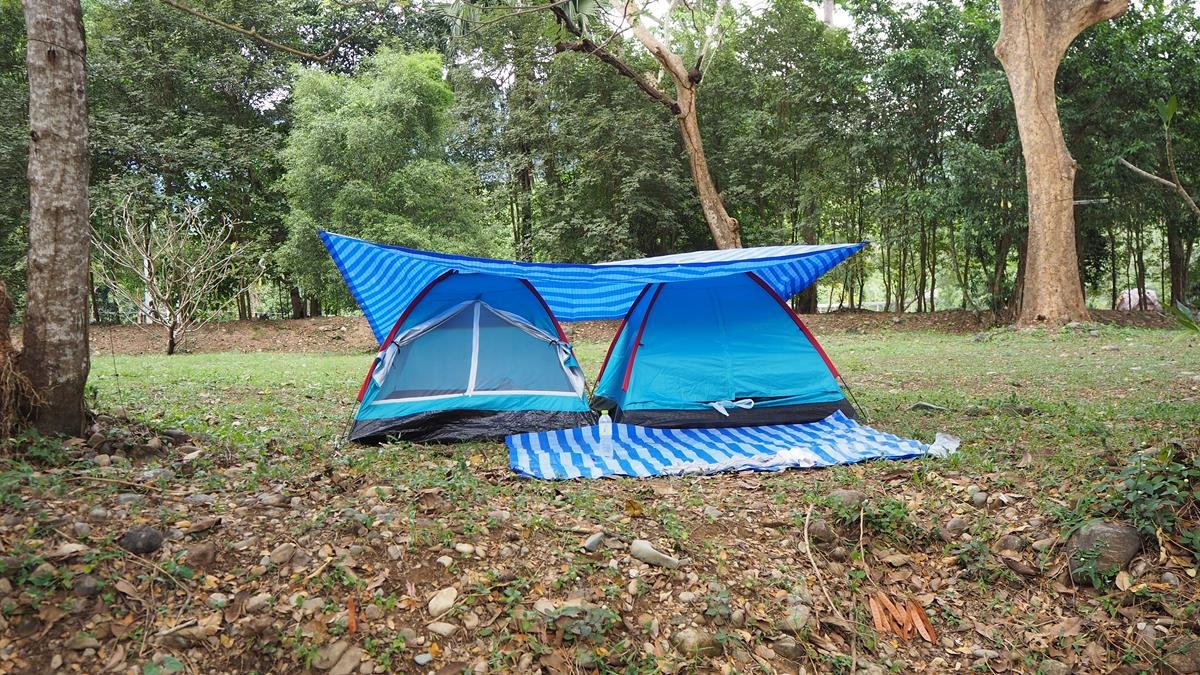Knowing how to get the most from your tent in all conditions that you are likely to face is a key to great camping trips.
Camping is an amazing pastime, offering an inexpensive way to see new sights and enjoy adventures. While camping during good weather is always good, you truly never know when the weather may change. This guide is for you if you are unsure on how to combat different weather conditions.
So, how can you get the most out of your tent in different conditions? While some tents are better prepared for weather conditions, there are tents that are designed to fit your exact camping needs. In order of importance, the conditions faced by most campers are:
- Hot temperatures
- Wind
- Storms or rain
- Cold temperature
Of course, the best way to guarantee that you are ready for the weather conditions you may face is to plan ahead and prepare. You should always check the weather in the area you are planning to camp. Having the right precautions in place can guarantee you make the best out of your camping experience.
Dealing with Camping in Hot Temperatures
You may be surprised that we list camping in hot temperatures as the most important condition to counter while camping. The fact is, most of us will camp in the late spring, summer and early fall. At those times of year, most parts of the US can be pretty darn hot.
We deal with this in much more detail in our post on ways to keep cool in a summer camping trip.
Keep Your Tent Cool During Warm Camps
While camping during the summer is a great time, it can also be extremely difficult to stay outdoors in the heat. If you are camping in a hot climate or during the warmer months, there are some ways that you can alter your tent to better fit your needs and give you a more comfortable camping excursion. Some simple changes you can make to your tent to keep it cool are:
| Use a tarp as a sunshade | You can buy purpose made reflective sunshades but, in our experience, you will get exactly the same effect with a regular tarp. Remember to take lots of paracord and, if you are not planning on camping near trees, a few poles to hold the shade.
|
| Use a Patio Sail as a Sunshade |
Shading your tent, and your living areas around the tent, is a major element of staying cool. We have moved on from using a tarp (which can look pretty ugly) on to using two patio sails. They are very lightweight and easy to put up. More importantly, they look incredibly cool. |
| Remove your rain fly | Rain flies add extra insulation to your tent. If there is no chance of rain, you can remove the rain fly to reduce insulation and increase ventilation. It’s usually quick and easy to replace a rain fly should the weather change unexpectedly |
| Take your tent down during the day | This is not something we ever do. Our tent is used for storage of all of our kit. We prefer to use the natural conditions to give us the best possible ventilation. While taking your tent down at the start of each day can seem counterproductive, it can help. A closed-up tent acts uncannily like a sauna and the static air inside can get very hot. When you put your tent up at the end of the day you will pull in fresh, hopefully cooler, air. |
| Make the most of natural airflow at you location | You will likely generate most airflow through you tent through the doors. You can maximize the airflow you achieve by orienting your tent to make the most of any local prevailing airflow. Of course, wind direction changes frequently and is affected by weather patterns, local mountains and hills, forestation and deserts. If you arrive in the afternoon, take note of which direction any wind is blowing and set up your tent so the wind will pass directly through the 2 doors. If there is no wind when you start to set up your tent, remember, in the US there is a prevailing westerly airflow. If there is no one to ask about local wind directions, set up your tent with the doors aligned East – West. It might not be right for your locale, but it gives you a fighting chance. |
| Make the most of natural shade | The most basic element of setting up to keep cool is to use natural shade. It’s easy to check where the shade is when you arrive at your campsite in the afternoon. Look for the shade from any trees or hills and pitch your tent there or where the shade will be a little later. It can be challenging to see exactly where the shade is during each part of the day, but you can usually figure it out based on where the trees are located. |
Extras to Bring Along
While these are the key ways that you can alter your tent to fit your needs while camping during the warmer weather, there are also some easy things you can bring with you that can help you fight the heat while in your tent. These items are sold at most stores, and you can pick them up before your next camping trip to protect against the heat. Some extra items to bring along for your trip are:
- A portable camping fan – Portable fans can easily be set up inside of your tent to bring in a breeze and keep the tent cool. There are several types of portable fans available that you can choose from, including battery-powered options that you can easily keep running even while camping. To keep things safe, you can grab fans made with foam blades to use directly inside of your tent, and these will not cause harm in close quarters.
The CampingSage Recommended Tent Fan is 02Cool 10” Fan
- Sleep in a hammock – If it is safe at your location and you are able to, sleeping in a hammock outside of your tent can actually be a great option. While it is recommended to always have a tent available should rain, or other circumstances arise, sleeping in a hammock is a great way to take advantage of the cool night’s air.
Of course, it is always great to check the weather prior to planning to sleep in a hammock as you do not want the temperature to drop too low or get caught in the rain. Also, make sure to use a bug repellent and be familiar with the area, avoiding pests is key.
- Bring an extra towel – Before laying down to go to sleep or during a very hot day, you can soak an extra towel with cool water and lay it across the back of your neck. This can help draw out heat from your body and can easily be flipped over when the cool side begins to get warm. While this is not a permanent fix, it is an easy way to drop your temperature rather quickly.
- Pack jugs of frozen water – A great camping hack to stay cool on hot days is to pack jugs of frozen water to bring along with you, these can easily be stored in a cooler and used as needed. While eventually, these jugs will melt, you can always use the water inside the jug to drink as needed during your camping trip.
- Sleep under a sheet – Sleeping bags are designed to keep you warm. A great way to lower the amount of heat you have while sleeping is to sleep under a sheet. You can easily sleep on top of the sleeping bag for a little extra comfort.
Keep Yourself Cool
If you are already hot and sweaty when returning to your tent, the tent will seem even hotter than it is. There are some basic personal things you can do to keep as cool as possible.
Here are some tips that may help you stay as cool as possible during your camping trip. These are things you can also keep in mind anytime you are going outdoors for extended periods or on very hot days:
- Stay hydrated! – It is extremely important that you are staying hydrated while you are out in the heat. You should never allow yourself to get dehydrated or overly thirsty while camping. While basic water is best and a cheap way to stay cool, you can also choose to drink Gatorade or other similar drinks that keep the body hydrated.
- Take a cold shower before sleeping – Prior to going to bed if it is possible to take a cool shower and lower your body heat, this can make sleeping each night a lot more relaxing and comfortable. If you can’t shower, bathing in cold water will bring down your internal temperature.

- Wear light-colored clothing – Darker clothing absorbs heat from the sun. Lighter colored clothing reflects heat. If you are camping during a warm, sunny day, you will want to wear lighter clothing so that you can combat soaking in more heat than necessary. It is best to only pack lighter clothing options that you can wear while away.
Protect Your Tent Against Strong Winds
At some point in your camping life you are going to be subject to strong winds. The very first time we camped as a family, there was a storm on the first night. Over half of the tents on the campsite were blown over and their contents spread around.
We were OK. We had a large, family dome tent. Maybe due to our inexperience we had made sure that every guy rope was deployed and each was separately staked. In truth, we were less bothered by the tent being affected by the blustering wind than we were by the noise the rain made on the roof of the tent. If you have never camped in heavy rain it is quite an experience. Raining hitting the roof and sides of the tent causes a lot of noise.
When we woke the next day it was a surprise to us all to see the carnage and wrecked tents around us.
There were some key lessons from this story:
The type of tent matters in the wind.
What are the best tents for high winds
Geodesic tents are designed to cope with strong winds and poor weather. Dome tents are pretty good too. We don’t know of any geodesic tents designed for the family camping market.

Most cabin tents and instant tents do not cope well with strong winds. Cabin tents are just not aerodynamic at all. The telescopic poles in instant tents are not as strong as the poles in other sorts of tent. A strong, blustery wind works at the poles and eventually breaks them.
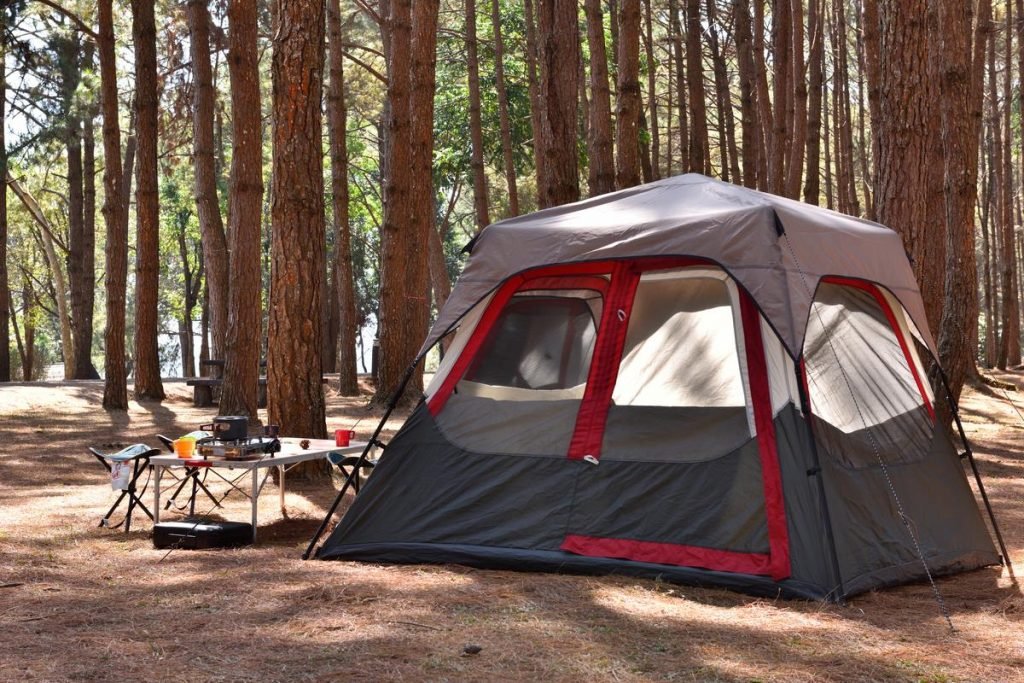
What Wind Speeds Can a Tent Withstand?
We have never seen a family tent supplier providing information on what wind speeds a tent can withstand. The table is based on a wikipedia article on wind speeds. We have added a column showing tent types suited to the wind speed shown
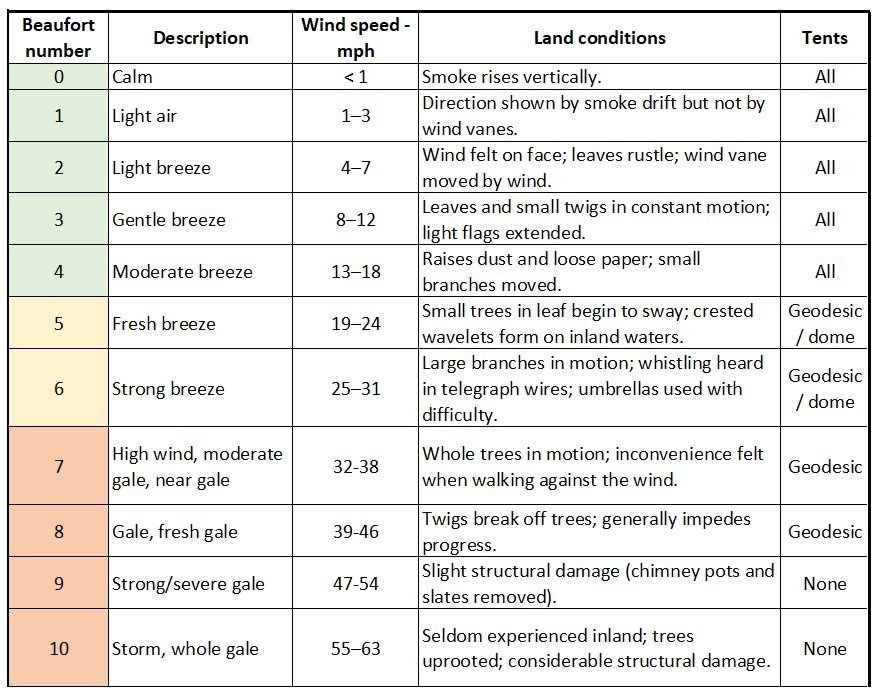
The energy, and hence the destructive power, of the wind is proportional to the speed squared. The energy in a 31mph ‘strong breeze’ is almost double that in a 24mph ‘fresh breeze’. The energy in a 38mph ‘high wind’ is almost double again.
It is the energy in the wind that knocks tents down. As you can see, the energy in the wind increases much faster than the wind speed increases.
While we think that all tents are good up to and including moderate breezes, setting up a tent in that sort of wind can be problematic. You will need to get the tent footprint pegged down very quickly before erecting the rest of the tent.
Setup Your Tent Properly
When you put up your tent in good weather it is easy to see unfurling and pegging all your guy ropes as a chore. Many family tents are freestanding (they will stand up without any external attachments or stakes) so it is tempting to erect the tent, get your kit inside and go off exploring.
As we saw – not setting your tent up properly can really ruin your day (or night). Simple tips:
- Use as many of the guy ropes that you have as possible, adding stones around poles for extra support.
- Ensure that you use all peg points that come with your tent to help make it as secure as possible.
- Set the tent up as securely as possible and drum-tight.
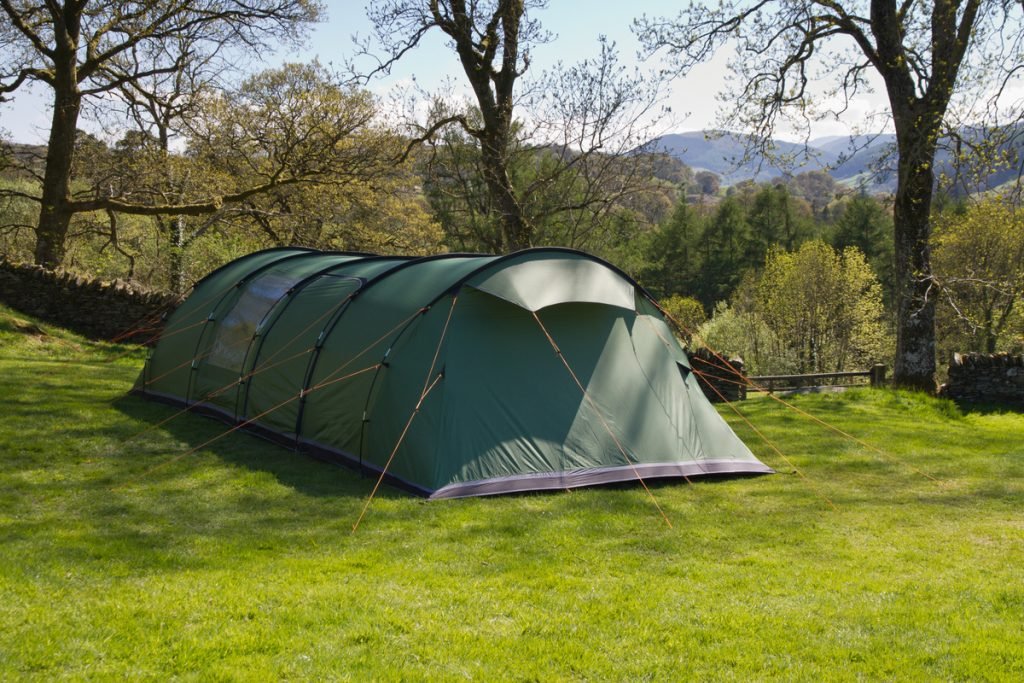
Prepare for Wind
If you know it is going to be windy you can use the shape and design of your tent to help you. Face the most aerodynamic part of your tent into the wind. This will mean pointing the lowest part of your tent to face the wind. It is easy to set up geodesic, dome and some ridge tents for windy conditions. For cabin tents it can be much more difficult.

How to Choose a Campsite on Windy Days
A big part of combating the wind is ensuring you set up your tent in a good place that is as protected as possible. Putting your tent in a quality location can increase your overall experience and better protect you against the elements. Some things to keep in mind when choosing your campsite are:
- Try to set up on level ground, which will make the entire process easier.
- Try to find somewhere that is somewhat sheltered. The best areas are behind a hill or a group of trees.
- Avoid camping underneath trees that look as if they may collapse. The last thing that you want is for the wind to be pick up and the tree to fall on your tent.
- Avoid fallen tree trunks or other unwanted debris that could hit your tent.
- If there is a chance of rain with the wind, you should set up on the slightly higher ground as this area will stay dryer.
- If winds are going to be excessively high, you should try to reschedule your trip or find a different location.
Preparing Your Tent for Cold Weather
If you are going to a location that is extremely low temperature, you need to have an insulated tent that will protect you. There are extreme precautions you must take if you are staying subzero temps but staying in an area that is simply cold takes less preparation. Some of the things that you can do to make your tent better functioning in cool weather are:
- Place a tarp under your tent: During colder months, the ground can stay far colder than the air temperature and stay cooler longer. If you want to prevent heat loss, the best course of action is to place a tarp sheet underneath your tent. Try to find a tarp that is as close as possible to the size of your tent.
- Add plastic sheets to outer tent walls: You can use spray adhesive to cover your outer walls and then add plastic sheets. This can reduce heat loss considerably but does risk you getting adhesive onto your zippers. This is only ideal for those who plan to continue camping in cold weather as it can be hard to remove from the tent.
- Cover the tent floor with blankets: As mentioned, during cold months, the ground is often cold, and while plastic under the tent can help, using blankets inside the tent can also help. The type of blanket is not super important, just ensure it is easy for you to carry and fits your tent well.
- Add a heating source: Of course, the best way to increase the heat in your tent is to add a heating source. There are small heaters that you can purchase for camping use like the Mr. Heater portal propane heater. For a safer option, you can choose a battery-powered heater or use heat packs inside of sleeping bags.
- Add padding under sleeping bags: If your tent allows for it, sleeping off the ground is best whether this is on pads or on an air mattress. While you sleep, your body temperature will drop dramatically, and having as warm a bed as possible is key. Keeping your body away from the cold ground is critical.
- Create a thermal shield: If you are in an area where it is snowy, you can actually use the snow to create a thermal shield, which is an extremely effective form of insulation. You can actually cover your tent with a thin layer of snow to add a layer of insulation. Never use too much as it can be too heavy and collapse the tent and this should really only be used in very cold weather.
Rainproof Your Tent Against Water
Rain is something that can happen fairly suddenly, and often even a slight chance of rain needs to be protected against. Keeping rain outside of your tent is ideal in any camping scenario. The best way to do this is by waterproofing your tent. Common forms of waterproofing are:
- Seal the seams by applying a seam sealer that keeps moisture from seeping through.
- Refresh the urethane coating on the inside of your rainfly and the floor of your tent, which protects against moisture.
- Adding a durable water repellent or DWR coating can help your rainfly shed extra water more effectively.
What to do When Sealants Fail?
While the seals on your tent should be closed tightly, these can break down over time and cause leakage. Unfortunately, you may not notice these leaky seams until the tent gets wet, which can be too late. The best thing to do is have the proper tools in place should you notice a seam has failed and repair it as soon as possible.
The items needed to repair a seam are:
- A rag
- Seam Sealer – these will vary based on the material of the tent that is being used. You want to make sure that you pick up sealer for your specific tent; for example, tents with polyurethane-coated fabrics require polyurethane sealant.
- Rubbing Alcohol
To properly seal any malfunctioning seams, you will want to:
- Unfortunately, you most often do not notice leaks until rain starts, but it is best to make any repairs during dry, sunny days. If you notice a leak, mark it somehow for later repairs. You will want to seal the seam on the underside of the fly and the inner side of the tent body.
- If there is seam tape that has come loose, you will want to gently remove it and peel off any sections. Make sure not to overly peel away the tape, stopping when sections are intact.
- Clean the area using your rubbing alcohol and whatever rag you brought. Then apply the new seam sealer onto the seams.
- Make sure to check other seams; it is common for them to begin to break down around the same time.
- Give the sealer time to dry completely before moving or putting away your tent.
Stormproof Your Tent
Now that you know more about how to protect against the wind and the rain, is there more you should do if a storm breaks out? There are a few extra precautions you can take while camping to ensure your tent will stand up to a storm.
Of course, if bad storms are expected in the area such as tornados, severe thunderstorms, hurricanes, etc. you should always reschedule your camping trip. No tent will stand up against heavy storms.
Similarly, to camping during heavy winds, you should always ensure you are putting your tent up as accurately and securely as possible. You will want to use all poles provided, all stakes, and try to tie the fly down to the poles or use any Velcro provided. However, some additional steps that you can take to protect against storms are:
- Try to set up in a sheltered spot – Putting your tent into an open space, you will be more susceptible to the elements. Trying to find a sheltered spot will help slow the wind and protect you from dangerous, heavy rains.
- Utilize awnings or verandahs – Many tents will come with an option to cover or zip up the front awning or veranda of the tent. If storms are in the forecast, you should choose to use the awning or veranda. This can help prevent wind from getting under the tent, which can cause it to lift away.
- Use a tarp to cover your tent – A great way to block out any excess rain and protect your tent further is to add a tarp over your entire tent. You can buy industrial sizes tarps that should fit easily over a large variety of tent sizes. You will simply secure the tarp in place, and it will help make your tent stronger and more waterproofed.
- Dig a trench around your tent – When storms take place, the rainfall is usually more abundant and takes place more quickly. This can cause water to build up and can risk your tent flooding. You can dig a trench around your tent so that water is directed into the trench and away from the inside of your tent.
- Buy anti-sink pole plate – Another negative that comes with excessive rain is that the soil can get very muddy, and your tent’s poles can begin to sink into the ground. You can either use a recycled piece of wood or buy pole plates to help protect against this.
Conclusion: How to Get the Most from Your Tent in All Conditions
Purchase the Best Tent Possible
There is not one tent that satisfies all of your needs. If you expect to camp regularly in extreme conditions you need the best tent possible.
Unless you are planning on lots of winter or extreme weather camping, picking the best tent possible really means buying the toughest tent possible. Extreme weather camping is not something associated with comfortable family camping so is outside the CampingSage scope.
Take the time to set up your tent properly
It is incredibly tempting to do the absolute minimum when setting up your tent. Take the time to unroll and deploy the guy ropes. Peg each rope down separately. You’ll be glad you did when that flash storm hits.
Take extra kit to help with the heat
As we have said, the most common problem when camping is the heat. You need to plan ahead, get a tent suited to the heat, camp in natural shade (or create your own with tarps or sun sails), and add a little extra ventilation.

